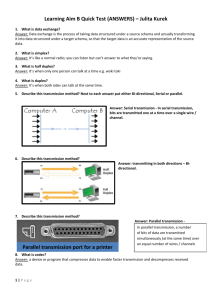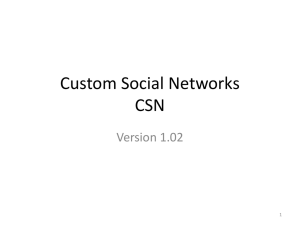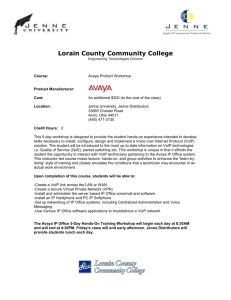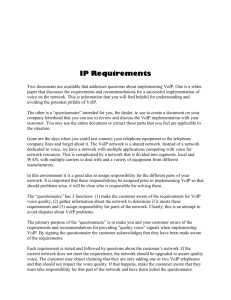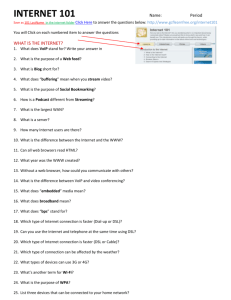TECH 682 Team 1 Technology Systems Assessment And Innovation
advertisement
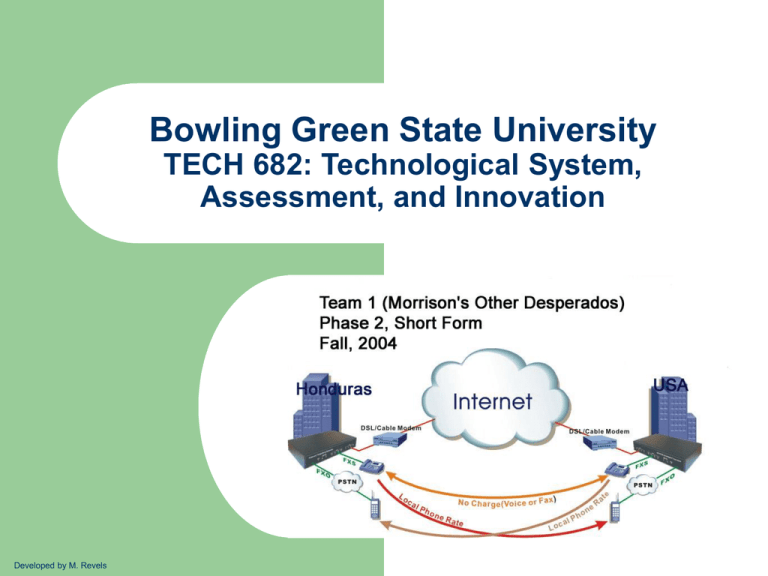
Bowling Green State University TECH 682: Technological System, Assessment, and Innovation Developed by M. Revels Team Members 2 Bruce, Richard (Assistant Team Leader) Dominguez, Miguel McKirahan, James (Team Leader) Morrison, Robert Nirav, Khichadia Ollison, Troy Revels, Mark (Secretary) Project Introduction 3 Traditional telephone systems use analog technology to transmit voice signals around the globe. Traditional telephone system costs can be very high for long distance communication, especially for international corporations with facilities located through the world. Project Objectives 4 The objective of this project is to successfully implement VoIP technology at an international company with facilities in Chicago, Illinois and San Pedro Sula, Honduras Project Goals The following goals support successful completion of the objective: – – – – 5 Definition of VoIP, ensuring it will meet the project needs Definition of the company’s needs, ensuring they can be met by the proposed solution Definition of the environment, ensuring it will support the VoIP solution Definition of critical success factors, ensuring that success can be measured Project Methodology 6 Two member subgroups were formed to research technical and cultural aspects of project Research data were gathered and processed using The Industrial Technologist’s Toolkit for Technology Management (Dr. John Sinn, 2004). Synchronous and asynchronous online collaboration tools were used to shape and define the project. Additional input from Dr. john Sinn was integrated as needed. Team Member Organization Chart Jim McKirahan Team Leader Richard Bruce Assistant Team Leader Mark Revels Secretary 7 Troy Ollison Miguel Dominguez Robert Morrison Nirav Khichadia Synchronous Communications Example 8 Asynchronous Communications Example 9 Research Data Summary 10 Data were collected and processed using The Industrial Technologist’s Toolkit for Technology Management (Dr. John Sinn, 2004). ITTTM Tools used included Tool 7, 8, 9, 10, 11, and 12 Research Data Description, Tool 7 Ongoing Process Control Plan (OPCP) – P-Attribute Statistical Process Control (PASPC) – 11 Used to insure controlled management of project processes, using process specifications, evaluation techniques, and corrective actions Used to manage performance of key project process variables Research Data Description, Tool 7 Cultural System Core Values (CSCVCBR) – ISO/QS Audit, Objective Prioritization Plan (ISOQSAOPP) – 12 Used to ensure entire team is cognizant of impact of technological innovation and change on cultural values. Preliminary ISO auditing tool Research Data Description, Tool 7 Documentation System Design, Communication (DSDC) – 13 Used to ensure and manage adequate project documentation. Research Data Description, Tool 8 Open Agenda Tracking, Corrective Action Form (OATCAF) – Technological Driver, Change Assessment, Innovation Analysis TDCAIA) – 14 Used to manage problems and issues that have yet to be corrected. Used to identify and assess change enablers and drivers. Research Data Description, Tool 8 Applications/Process Engineering, Innovation, Applied Research (APEIAR) – 15 Used to manage the need for further research, engineering, or applied assessments in order to enhance project success. Research Data Description, Tool 9 General Inspection System, P Data Collection System (GISPDCS) – Standard Operating Procedure Analysis (SOGA) – 16 Used to manage performance of key project performance variables. Defines project process procedures/operations in order to achieve process optimization. Research Data Description, Tool 9 General Cost Analysis (GCA) – 17 Used to manage financial performance of project, including key financial performance indicators such as break-even and return on investment. Research Data Description, Tool 10 Preliminary Technology Transfer, Development and Resource Audit (PTTDRA) – Quality Function Deployment (QFD) – 18 Used to manage developmental technology transfer issue. Used as a structured method in which customer requirements are translated into appropriate technical requirements for each stage of product development and production. Research Data Description, Tool 11 Cultural Political Correctness Audit, Tradition, Change Planning (CPCATCP) – Failure Mode and Effects Analysis (FMEA) – 19 Used for identification and analysis of the impacts that technology has on cultural and social issues Used to rate and analyze process, design, or product failures and effect in an effort towards critical improvements Research Data Description, Tool 11 General Safety Inspection Checklist/Pareto Chart (GSICPC) – 20 Used to examine and document safety issues in an operational environment, which with associated charts, will provide the foundation for changes and improvements. Research Data Description, Tool 12 General Benchmarking/Auditing Process, Systems (GBAPS) – 21 Used to determine variation between process, products, or issues of different groups for the purpose of general improvement. Research Data Description, Tool 12 Technology Transfer, Development, Environment/Resources Assessment (TTDERA) – 22 Used to make the technology systems more environmental, resource, and technology transfer appropriate; and to reflect these changes in other necessary documentation systems . Project Process Reflections 23 Significant improvement occurred in the threaded postings, tool documentation devices, and research toward the technical project. Compilation dates have been moved up to facilitate quality into the Phase Portfolio. The project is moving along well, but there are issues. For example, I don't believe we have determined exactly which vendor will be our supplier. While these forms are great and collecting lots of random information, they don't seem to be as well suited for bringing consensus in the group… Project Process Reflections 24 Quality of work is improving by each team member. Threads are improving and the technical project is progressing nicely. Team members need to become more proficient and timely in the posting of this and other tool documents. Project Process Reflections 25 The research our team is performing is continually becoming more focused and complete as we move toward our end project. At this point I think we have more than enough information to accurately understand the technical aspects of VoIP technology. However, the cultural aspects are still somewhat vague due to the lack of research our team has been able to collect in this area. Project Process Reflections 26 The quality of work looks satisfactory but the content may need to be directed more toward the cultural aspects of implementing a VoIP communication system in Honduras and Chicago. However, the cultural impact of implementing VoIP may be minimal due to the close similarities between the operation of VoIP phones and traditional telephones. Project Findings 27 After some question as to the actual components required to implement VoIP including the costs involved, feasibility, cost effectiveness, and quality issues, the tool forms defined and addressed the project objectives. The most difficult aspect to address with the technical project, cultural influences upon our technology transfer, although not fully developed, emerged in the Phase Portfolio. Project Findings 28 In-house development of VoIP system cost anticipated to be have initial cost greater than $6000 as a result of technical resources requirements. Ongoing costs will also be incurred. Outsourcing VoIP service to major supplier (such as Vonage, Net2Phone) reduces cost to $400 initial, with $20 per month ongoing. Project Findings 29 Outsourced system technology was tested during synchronous meeting of 11/29/04. Contact was established between Jim McKirahan (Team Leader) in the U.S., and Robert Morrison in Honduras. Project Conclusion 30 VoIP is real and ready for use. Outsourced solutions can be very cost effective. Network capabilities are a fundamental consideration



